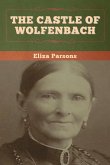The whole affair is certainly very strange: often has the Marquis vowed to apply either to the Count or courts of justice; but the letters we received were never written by her, we could adduce no actual proofs of his guilt, and she continually warned us to take no steps without her permission. Thus, in a most unaccountable manner we are prohibited from doing her justice, whilst all the world believes her dead: he lives chiefly at Vienna, a dissipated life; though from my friend I hear he is at times gloomy, and apparently unhappy: this gentleman however believes my sister and her child dead, nor dare I undeceive him.








